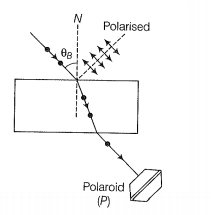Consider a light beam incident from air to a glass slab at Brewster's angle as shown in the figure. A polaroid is placed in the path of the emergent ray at point \(P\) and rotated about an axis passing through the centre and perpendicular to the plane of the polaroid. Then:

| 1. | for a particular orientation, there shall be darkness as observed through the polaroid. |
| 2. | the intensity of light as seen through the polaroid shall be independent of the rotation. |
| 3. | the intensity of light as seen through the polaroid shall go through a minimum but not zero for two orientations of the polaroid. |
| 4. | the intensity of light as seen through the polaroid shall go through a minimum for four orientations of the polaroid. |
Hint: \(I=I_0 \cos ^2 \theta\)
Explanation: Consider the diagram, the light beam incident from air to the glass slab at Brewster's angle (IP). The incident ray is unpolarised and is represented by a dot (.) The reflected light is plane polarised, represented by arrows.

The emergent ray is partially polarised, hence the intensity of the light passing through the polaroid cannot be zero when it passes through the polaroid, but the minimum for two orientations of the polaroid.
Therefore, the intensity of light as seen through the polaroid shall go through a minimum but not zero for two orientations of the polaroid.
Hence, option (3) is the correct answer.

© 2025 GoodEd Technologies Pvt. Ltd.